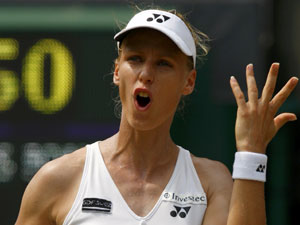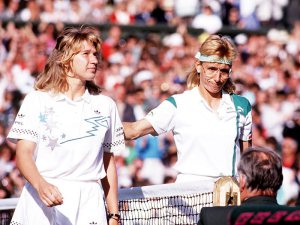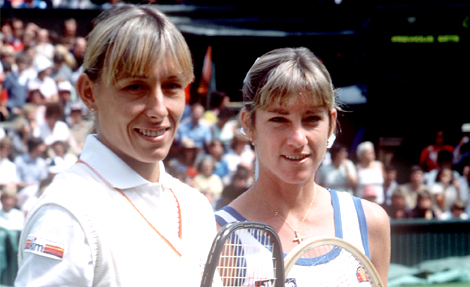The All-England Club is where history lives and breathes more fully in tennis. So many of the sport’s important dramas and contentious rivalries have come alive in its most tradition-soaked setting. Keeping in mind that this list is not a measurement of pure quality or drama, here are the 10 most significant women’s matches of all time at Wimbledon… not as a matter of fact, but as one person’s opinion:
10 – 1973 FINAL: BILLIE JEAN KING d. CHRIS EVERT, 6-0, 7-5
The resonance of this match comes from two sources.
First, the result is amplified by the fact that 10 years after her first Wimbledon final in 1963, Billie Jean King was able to turn back a member of tennis’s new guard. King met a 16-year-old Evert in the 1971 U.S. Open semifinals and could see that her younger opponent represented the future of tennis in America and beyond. King’s ability to win the 1973 title against the foremost up-and-comer in women’s tennis at the time showed how well King was able to extend her prime years. She resided at or near the top of women’s tennis for a solid decade, from 1966 through 1975, all while being one of the main leaders of the movement to promote and solidify a full-fledged and unified women’s tennis tour.
This match is also noteworthy because it marked the beginning of Evert’s “almost-but-not-quite” history at Wimbledon. The greatest female clay-court player of all time (at least in the eyes of many) couldn’t quite duplicate her French Open success on the lawns of the All-England Club. Evert achieved richly at SW19, winning three championships, but she lost in seven finals, this being the first of them. If Evert had managed to go 7-3 instead of 3-7 in Wimbledon finals, she’d probably be viewed as the consensus choice for the greatest female tennis player of all time. As it is, Evert will remain in that discussion, but her Wimbledon finals record is what likely puts Martina Navratilova and Steffi Graf ahead of her. (Serena Williams represents a separate discussion.)
9 – 1970 FINAL: MARGARET COURT d. BILLIE JEAN KING, 14-12, 11-9
The tiebreaker, created by Jimmy Van Alen, did not arrive at Wimbledon until 1971. It debuted in the majors at the 1970 U.S. Open. Therefore, the two best women’s tennis players of their time were forced into death-march tennis, both at a period in their careers when they did not enjoy peak health.
Court didn’t win as many Wimbledon singles titles as King. SW19 became a spiritual home of sorts for King — she entered only one major tournament in 1975, and she won the last of her six Wimbledon crowns. Nearing 40 years of age, King made the Wimbledon semifinals in 1982 and 1983. Therefore, Court’s display in 1970 — in which she outlasted her most accomplished contemporary on the sport’s biggest stage — offers what many would regard as the single most convincing reason to elevate the Australian’s status on the list of all-time great female tennis players.
Court fattened up her 24-major trophy count at the Australian Open (11 titles), where the other top players of her era frequently failed to attend. Court’s win over King inside Centre Court Wimbledon, the cathedral of tennis, likely represents her greatest match victory. The fact that the win helped Court achieve the calendar Grand Slam in 1970 only adds to the enormity of this match in the larger history of women’s tennis.
8 – 1938 FINAL: HELEN WILLS d. HELEN JACOBS, 6-4, 6-0
Before Martina Navratilova won nine Wimbledon singles titles, Helen Wills established the benchmark by winning eight, and it was in the 1938 final that she attained this feat. Wills made her first Wimbledon final in 1924. Roughly a decade and a half later, she reached her last championship match at The Championships.
Wills played (and defeated) Jacobs in the 1929 final, beginning a remarkable sequence in which the two Americans contested four Wimbledon titles in three-year intervals. Wills and Jacobs reunited in the 1932 and 1935 finals. When they met again in 1938, they had to know that their every-three-years dance at Wimbledon was going to come to an end. Moody’s ability to turn back Jacobs each and every time they played in a Wimbledon final is what most centrally enabled her to win eight titles. Jacobs, to her immense credit, finally managed to break through and win her only Wimbledon singles crown in 1936 after three losses to Wills in finals.
*
7 – 2002 FINAL: SERENA WILLIAMS d. VENUS WILLIAMS, 7-6 (4), 6-3

The Williams Sisters contested four Wimbledon singles finals, keeping a lot of prize money, prestige, and championship glory in the same family. In light of what the Williamses have endured over time, the reality of seeing Serena and Venus compete for championships on Centre Court represented the culmination of a family’s triumph within — and over — the sport of tennis.
In 1957, 45 years earlier, Althea Gibson became the first African-American woman to win Wimbledon. When Serena and Venus met in their first Wimbledon final, there was an undeniable awareness — in the present moment, not just in retrospect — of the magnitude of the occasion. Yes, the two women had met before at Wimbledon (the 2000 semifinals), and yes, they had contested a major final the year before at the 2001 U.S. Open, but when Richard and Oracene’s daughters took to Centre Court on Championship Saturday, the journey from Compton, California, had in many ways reached its zenith.
Navratilova has nine Wimbledon singles championships. The Williams Sisters have 10, the product of four Serena-Venus meetings in Wimbledon finals. Tennis might be a solo-athlete sport, but the Williamses’ shared ownership of Wimbledon one of the more powerful and moving stories in the history of tennis.
6 – 2008 FINAL: VENUS d. SERENA, 7-5, 6-4
Her three-set win over Lindsay Davenport in the 2005 Wimbledon final represents Venus Williams’s best single-match performance at The Championships. However, Venus’s most significant win at Wimbledon came in 2008, when she scored her lone win over Serena in four Wimbledon finals between the two siblings. Being able to defeat her younger sister on this stage undeniably adds a substantial degree of heft to Venus’s overall Wimbledon resume. When she lifted the Venus Rosewater Dish on this particular Saturday, she knew she had achieved something special.
5 – 1991 FINAL: STEFFI GRAF d. GABRIELA SABATINI, 6-3, 4-6, 8-6
Steffi Graf’s legacy at Wimbledon — seven titles, won with methods substantially different from those used by Navratilova to win her nine — was built on the back of her ability to win tough three-set finals. She benefited from Jana Novotna’s choke in 1993. She fended off Arantxa Sanchez Vicario in 1995. She rose above Navratilova in 1988 and 1989. Yet, when one realizes that Navratilova was in her early 30s in ’88 and ’89, it was in 1991 when Graf had to go about the task of beating contemporaries and not elders. It was this triumph over Sabatini which knitted together Graf’s late-’80s and mid-’90s titles at SW19.
4 – 1992 FINAL: STEFFI GRAF d. MONICA SELES, 6-2, 6-1
The grunting controversies that regularly visit tennis in the present day were very much a part of the 1992 Wimbledon ladies’ singles tournament. Monica Seles, known for emitting a loud vocal utterance when hitting a ball, was warned multiple times in her semifinal win over Navratilova. When she took the court against Graf in the final, she made a concerted effort to play quietly… and she wasn’t the same player who had begun to take over women’s tennis in the years before the stabbing that hijacked her career in 1993.
Naturally, that stabbing is what forever changed the Seles-Graf equation in women’s tennis, substantially altering the sport in the 1990s. Yet, this match retains significance precisely because it magnifies the extent to which grunting — no matter what you might personally think about it — has become more commonplace in both the women’s and men’s games, Marcel Granollers being a serial grunter/yelper on the ATP Tour. One can only wonder why warnings were issued toward Seles in 1992, but are not handed out to today’s foremost stars, Maria Sharapova and Victoria Azarenka.
*
3 – 2009 SEMIFINAL: SERENA WILLIAMS d. ELENA DEMENTIEVA, 6-7 (4), 7-5, 8-6

Elena Dementieva might have played the best major-tournament match of her career against Serena Williams in the 2009 Wimbledon semis. It wasn’t enough. That shattering reality underscored the “so close yet so far” nature of Dementieva’s career at tennis’s biggest tournaments.
This match, one of the best in Wimbledon’s long and storied history, was important on a secondary level because it denied Dementieva a chance to make her first Wimbledon final. This match, in many ways, represented Dementieva’s last best shot at a major title. Dementieva — when she retired a few years ago — was widely considered to have been the best player on the WTA Tour to have never won a major championship. The result of this match ensured that the Russian would not shed that most unfortunate distinction.
With that having been said, the primary element of significance in this match is that it was one of the two or three events which re-ignited Serena’s career.
We know and recognize Serena as one of the great champions of women’s tennis, with 17 majors to her credit. Yet — and this is harder to appreciate with the passage of the years — there once was a time when Serena’s career was clouded by doubt and frailty. Injuries, depression, and questions of motivation defined the deep, dark valley of her career from 2004 through early 2008. From the 2003 U.S. Open through the 2008 Wimbledon tournament — a span of 20 majors — Serena took home only three titles. It’s true that women’s tennis was loaded with great players at the time. Venus, Justine Henin, Kim Clijsters, Maria Sharapova, Dementieva, a more consistent version of Svetlana Kuznetsova, and Lindsay Davenport (among others) made life on the WTA Tour anything but a cakewalk. Yet, Serena’s dominance of women’s tennis in 2002 and 2003 pointed to a sustained ascendancy, and for that reason, the 2004-2008 dry years still represented something of a surprise.
This match — a vintage Serena comeback forged from the fires of crunch-time pressure — did a lot to rejuvenate the younger Williams’s career. Dementieva had a match point at 5-4 in the third set, and had a passing shot lined up. Serena, though, guessed correctly at net and barely converted a volley to live another point. Serena used that one moment to advance to the final and defeat Venus in what would be her older sister’s last Wimbledon final. Serena has won two more Wimbledons since 2009, matching Venus’s total of five. Circle the 2009 semifinal against Dementieva if you want to identify the point when Serena’s Wimbledon career took a decisive turn for the better after many years of struggle.
2 – 1982 FINAL: MARTINA NAVRATILOVA d. CHRIS EVERT, 6-1, 3-6, 6-2
It was during the 1981 U.S. Open that the old Martina Navratilova — out of shape and in love with the material comforts of a relatively new American life — began to give way to the new Martina, the one who rededicated herself to the sport and, in the process, changed the way top tennis players took care of themselves during each season on tour.
In order to prove that her transformation meant something, however, Navratilova had to complement her new approaches to fitness and tactics with good old-fashioned mental toughness, an elusive ingredient to that point in her career. Being able to outlast Evert, her foremost rival, gave Navratilova — a player whose game was made for grass — the inner liberation needed to subdue Wimbledon for a long time. Beginning with that 1982 championship, Navratilova didn’t lose another singles match at Wimbledon until…
*
1 – 1988 FINAL: STEFFI GRAF d. MARTINA NAVRATILOVA, 5-7, 6-2, 6-1

When a young Steffi Graf managed to dethrone the Queen of Wimbledon, Martina Navratilova, in 1988, she set out on a career that left virtually no accomplishments on the table… and ended just weeks after her 30th birthday.
The greatest female singles players of all time — if put up to a vote — would very likely produce this Final Four: Serena, Graf, Navratilova, and Evert. Serena’s prowess well into her 30s, especially her ability to continue to thwart her foremost rivals in major tournaments, is what’s enabling her to move up the ladder in the all-time discussion. Evert’s case rests on her ability to master Parisian clay at Roland Garros while also hauling in six U.S. Opens, more than either Graf or Navratilova. The argument for Navratilova is based on her ability to overtake Evert in the head-to-head matchup between the two in the 1980s, especially at the majors in 1982 and beyond.
The argument for Steffi Graf? Despite the fact that she was not yet 20 years old, she was able to beat a seasoned Navratilova on the sport’s biggest stage when the serving-and-volleying lefty was still a central presence in women’s tennis. Graf lost a tough first set to Navratilova on that sun-drenched afternoon at the All-England Club, and it was reasonable to think that Wimbledon’s greatest modern-day singles champion was going to win her seventh straight title. However, Graf then steamrolled through the final two sets, sending notice to her opponent and the whole of the global tennis community that she was worthy of — and ready for — greatness.
Graf’s superiority over anyone who stood in her path was often manifested in the form of overwhelming dominance, but as has been said earlier in this survey of the most significant women’s matchs of all-time at Wimbledon, Graf’s greatest asset was her ability to persevere in three-set matches. She would continue to win many more three-set finals as her Wimbledon career unfolded, but this is the one that sent her on her way… and also allowed her to complete the “Golden Slam,” complete with an Olympic gold medal, in 1988.
Perhaps 1988 doesn’t end the argument about the greatest women’s singles player of all time — one can debate that point. However, without 1988, it’s obvious that Graf’s case wouldn’t be nearly as convincing as it is… and will long continue to be. If you’re a tennis player looking to improve, be sure to check out this article on tennis sensors, which can help you take your tennis game to the next level.

